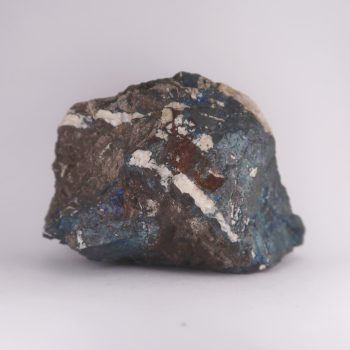Bornite
Bornite is a copper and iron sulfide mineral which is used as an ore of copper. It is sometimes known as ‘peacock ore’ due to a habit of tarnishing in iridescent colours.
However, this is often faked, with most ‘peacock ore’ being an acid dipped Chalcopyrite.
Showing the single result
Information about Bornite
Bornite is a copper iron sulphide mineral with an unmistakable iridescent tarnish that displays vibrant hues of purple, blue, green, and gold.
It is sometimes referred to as ‘peacock ore’ – I prefer to avoid using this trade name as many specimens online sold as ‘peacock ore’ are an acid dipped chalcopyrite.
Its fresh surfaces are typically a metallic copper-red to bronze colour, but exposure to air quickly leads to its characteristic colourful tarnish.
It commonly forms massive aggregates, but well-formed crystals are rare and are usually cubic or dodecahedral.
Uses and History
Bornite is a significant copper ore, mined extensively for its copper content, which is critical in electrical wiring, plumbing, and industrial machinery. Beyond its industrial utility, bornite is popular among collectors for its striking colours and is often displayed as a decorative mineral specimen.
Bornite was first described in 1725 and was later named after the Austrian mineralogist Ignaz von Born in 1845. The mineral played an essential role in the early discovery and processing of copper, contributing to the development of metallurgy in ancient and modern civilisations.
Mineralogy
Coppery red-brown, tarnishing to an iridescent purple-black surface.
Hazards and Warnings
Mineral collectors should wash their hands after handling specimens, to avoid any exposure to potential toxins.
Almost all rocks, minerals (and, frankly, almost all other substances on earth) can produce toxic dust when cutting, which can cause serious respiratory conditions including silicosis.
When cutting or polishing rocks, minerals, shells, etc, all work should be done wet to minimise the dust, and a suitable respirator or extraction system should be used.
Translations
Arabic:
Hindi:
Portuguese:
Bengali:
Indonesian:
Punjabi:
English:
Italian:
Russian:
- Борнит
French:
Japanese:
- 斑銅鉱
Spanish:
- Bornita
German:
- Bornit
Korean:
- 보나이트
Thai:
Gujurati:
Mandarin Chinese:
- 斑铜矿
Urdu:

